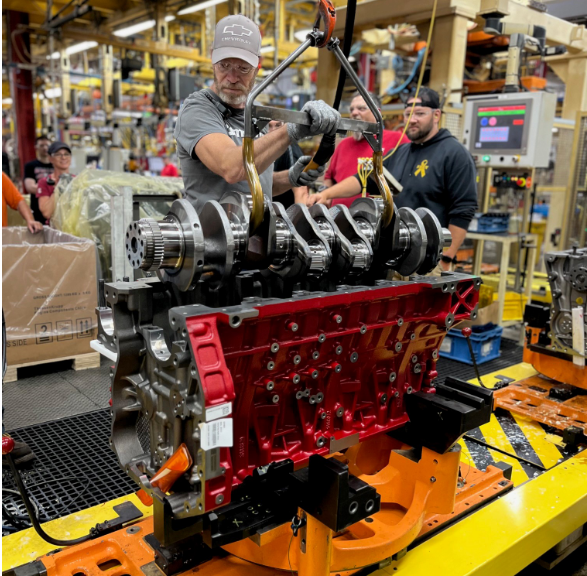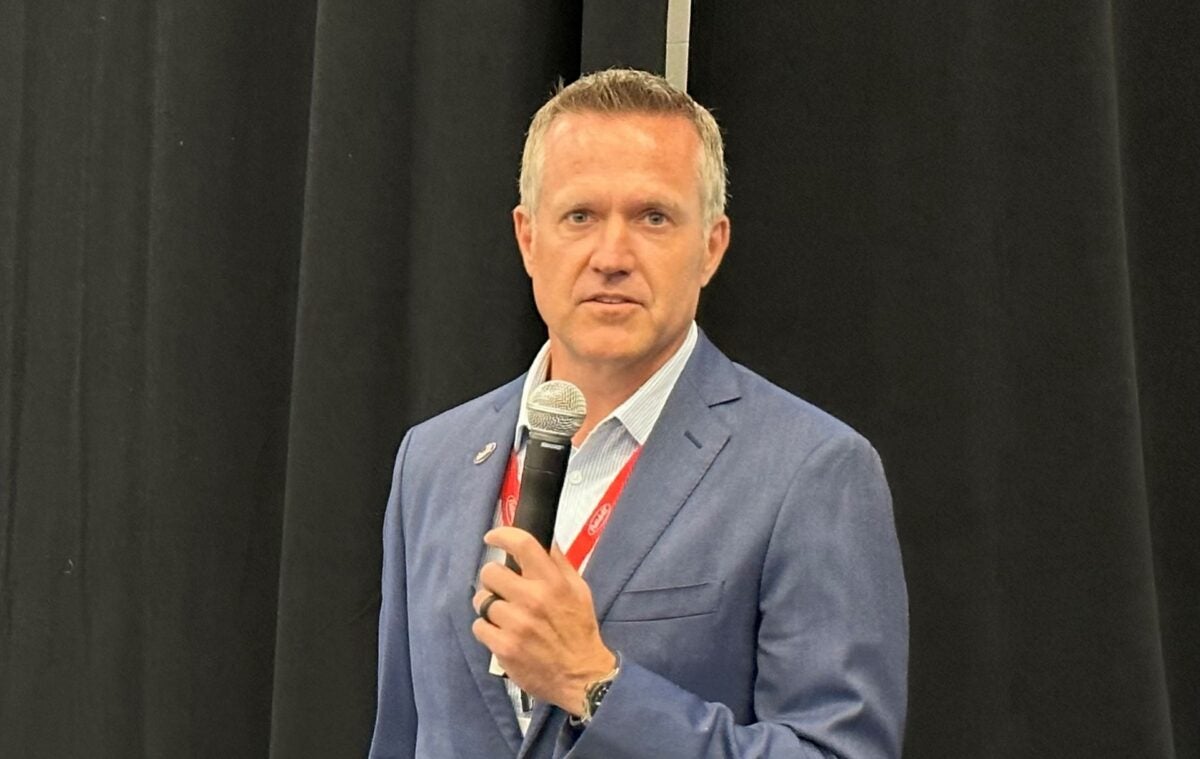Freight News:
Cummins predicts huge growth in natural gas engines
Cummins Inc. predicts its new 15-liter natural gas engine designed for heavy-duty and on-highway applications could lead to a five-fold growth in customers for the alternative powertrain. It overcomes complaints about low power and torque and can run on potentially net-zero carbon renewable natural gas (RNG).
“I’m not saying that this market will go 80% natural gas. But it’s no longer a niche,” Jose Samperio, Cummins’ executive director and general manager, North America On-Highway, told FreightWaves. “It becomes more mainstream for long-haul applications.”
Cummins’ strategy of making its next-generation 15-liter engine fuel agnostic — beginning with natural gas and followed by hydrogen and other fuels — is getting attention from OEMs and large fleets.

‘Exactly what we’re going for’
The X15N offers 400-500 horsepower and 1,450 to 1,850 pound feet of torque, comparable to the oomph of a diesel with a smaller carbon footprint.
“When the reference point is a 15-liter diesel and you hear drivers tell you that this engine drives amazing, that’s exactly what we’re going for,” Samperio said.
Werner Enterprises was first to sign on to test the X15N engine in January 2022. The engine powers the Shell Starship 3.0 experimental freight efficiency test truck. Knight-Swift is testing the engine in Southern California and reporting lower emissions of nitrogen oxides (NOx) and greenhouse gasses.
Paccar’s Peterbilt and Kenworth brands said in August they would offer the engine. More recently, Daimler Truck North America (DTNA) said in early October it would be an option for its market-leading Freightliner brand.
“Now you have a couple of brands recognizing the need. That’s why from a market perspective, less so from our side, but more from a market side, this is a great signal of it starting to become a real option,” Samperio said.
Expanding the market
A 15-liter offering expands the addressable market for natural gas. Natural gas traditionally accounts for about 2% of heavy-duty truck engines.
“We were participating in half the market [with] a 12-liter product that couldn’t do the job of a 15-liter,” Samperio said. “Now we have a 15-liter that can do the job of a 15-liter and do the job of a 12-liter. Do some simple math. You’re essentially doubling your market presence.
“Without assuming that you’re going to gain share necessarily, but just market availability, you are in the 6, 7, 8% range. We could see it in a few years from now developing into a potentially 10% market.”

Fuel systems, too
Cummins debuted the X15N in China in 2020. The decision to bring the platform stateside led to a $452 million upgrade to its plant in Jamestown, New York.
Enough customers indicated interest in a larger natural gas engine that Cummins greenlighted it for the U.S. Cummins is phasing out its 9-liter engine and 12-liter natural gas offerings. A 10-liter engine replaces those and will be capable of running on a range of fuels like the redesigned flagship X15.
“Based on what we are hearing, there are a number of fleets interested in the new 15L Cummins natural gas engine,” said Steve Tam, a vice president at ACT Research. “It is logical to conclude that at least some of this interest will likely result in purchases.”
In addition to the new engine, Cummins produces natural gas fueling systems — the tanks visible on the back or top of a cab or in a saddle format, depending on the vocational vehicle.
“Fuel delivery is a big integral part of the entire system,” Samperio said. “We have tons of opportunities for integrating the product.”
A transitional solution
Natural gas is a lower-carbon alternative to diesel. Using renewable natural gas made from dairy waste and other non-petroleum feedstocks could drop its CO2 emissions into net-zero territory. However, because it burns and combusts in an engine chamber, it creates smog-forming NOx emissions.
The X15N expects to meet 2027 Environment Protection Agency standards for NOx. In the march to zero emission trucks, natural gas will fall away. But that could be decades from now.
“Natural gas can be a good transitional fuel,” said Johan Agebrand, Volvo Trucks North America (VTNA) director of product marketing. “Eventually, we all have to get to true zero-emission vehicles, which are going to be hydrogen or battery electric of some kind.”
VTNA adapts its own engines for a natural gas system from Westport Fuel Systems, a longtime joint venture partner of Cummins. Columbus, Indiana-based Cummins purchased Westport’s stake for $20 million in 2022 after their 10-year collaboration ended in December 2021. Six months earlier, Cummins purchased 50% of Momentum Fuel Technologies, a subsidiary of Rush Enterprises.
‘Bridge to a cleaner future’
Jason Skoog, a Paccar vice president and Peterbilt general manager, follows Samperio’s thinking about the potential expansion of the natural gas engine market. Peterbilt will offer the X15N in the second half of 2024.
“We already sell a bunch of natural gas business today,” Skoog told FreightWaves. “We have a couple of customers that run natural gas. And they do it because they feel it’s a bridge to a cleaner future.
“The 15-liter gives [natural gas] more of a long-haul application,” he said. “I think we will grow our sales on an annual basis. Are we going to double our sales of natural gas engines? Maybe not in the first year.”

A lot of those engines, like Knight-Swift’s pilot in California, will use RNG. It accounts for 97% of natural gas in the state and 69% nationally.
“From a well-to-wheels perspective, you can get there without making any sacrifices,” Sampiero said. “We have a big-bore engine participating in a new market, a new customer base, and we see all of the fuel suppliers investing not only on the distribution but also on the production of the fuel coming in.”
Still, DTNA is careful about predicting future X15N adoption.
“We’ve had natural gas [offerings] since 2009-2010. We have a number of customers that set up their own infrastructure and utilize natural gas that’s been available and had success in running it,” said Greg Trienen, DTNA vice president, On Highway Market Development.
“We want to make sure we support those folks especially as we’re still in the infancy of finding the right mix of zero-emission and low-emission vehicles.”
A future of multiple powertrain offerings
As excited as Samperio is about growing the natural gas market, it is just one step on the path to Cummins’ 2050 goal of zero emissions in its engines. Half of all medium- and heavy-duty engines on U.S. roads are made by Cummins.
“Yesterday, diesel was fully dominant,” Samperio said. “But as we get into later in the decade and into the 2030s, it’s going to be a multi-technology environment where people are going to choose not only what’s best for their operations, but also what’s best from a sustainability perspective.”
If natural gas engines reach the 10% market share Samperio predicts, the customers may shift from the ones who buy it initially. Regions and rural areas where electric vehicle infrastructure lags might provide the future customers where fueling for natural gas may be more available broadly than electricity or even hydrogen.
“I don’t know that we ever will have one [powertrain] in the future,” Peterbilt’s Skoog said. “I think it’s going to take a variety of different modes including diesel to power the future, at least for the next couple decades.”
Related articles:
1 for 2: Cummins replacing 9- and 12-liter engines with new 10-liter
Cummins plans $1B+ investment in engine plants, hydrogen equipment
Cummins expands natural gas offerings with 15-liter engine
Click for more FreightWaves articles by Alan Adler.
The post Cummins predicts huge growth in natural gas engines appeared first on FreightWaves.
Source: freightwaves - Cummins predicts huge growth in natural gas engines
Editor: Alan Adler